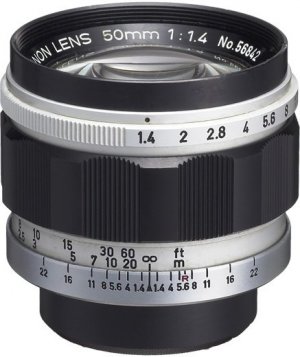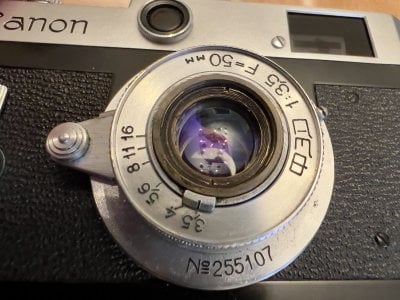Loovic07
Newbie
Hi all i'm new here so be kind !
I shoot film with 35mm 6x6 and 6x7 but recently I got a hankering for a rangefinder camera – upshot is that I have a Canon P on its way. Looking at lenses I normally shoot 50mm, 35 and occasionally 28. I am looking for a 50mm for the P and was wondering how the forum rates the Industar 50mm, also is there a fit issue when collapsed on the P ?
I shoot film with 35mm 6x6 and 6x7 but recently I got a hankering for a rangefinder camera – upshot is that I have a Canon P on its way. Looking at lenses I normally shoot 50mm, 35 and occasionally 28. I am looking for a 50mm for the P and was wondering how the forum rates the Industar 50mm, also is there a fit issue when collapsed on the P ?
Last edited by a moderator:
The Industar-50 50mm F3.5 is nice, inexpensive, and compares well with a Leica Elmar 5cm F3.5. "The Catch", the ex-USSR lenses are made to the Zeiss standard. Even the F3.5 lens will benefit from adjusting the shim. You do get lucky sometimes. Probably "50/50" on the I-50 and I-22.
The Canon P and Canon 7 have Light Baffles internally, and collapsing a lens can hit them. Even the Canon made collapsible 50mm F1.9 will hit them.
Best advice: If you get the collapsible, open the camera up and hold the shutter open. Collapse it slowly and watch for an issue.
 rangefinderforum.com
rangefinderforum.com
The Canon P and Canon 7 have Light Baffles internally, and collapsing a lens can hit them. Even the Canon made collapsible 50mm F1.9 will hit them.
Best advice: If you get the collapsible, open the camera up and hold the shutter open. Collapse it slowly and watch for an issue.
Industar-50 Lube and Adjust
This Industar-50 is a Tessar formula 50/3.5 in a brass mount with "very shiny Chrome". Performance compares well with the post-war 50/3.5 coated Elmar. The I-50 is the third formulation of the 50/3.5 Tessar in the Industar series, it improves on the optics of the Industar-22 and Industar-10. The...
 rangefinderforum.com
rangefinderforum.com
Loovic07
Newbie
"Even the F3.5 lens will benefit from adjusting the shim"
Could you please elaborate on this; sorry I don't know what it means?
Could you please elaborate on this; sorry I don't know what it means?
I followed me own advice...
The Locking Flange on an Industar-50 will rub against the light baffles on the top of the camera as you collapse it.
The Locking Flange on an Industar-50 will rub against the light baffles on the top of the camera as you collapse it.
The Ex-USSR lenses are made to a slightly different standard of focal length compared with the calibration of the camera. The Zeiss standard is 52.4mm and the standard used for Leica and the Canon is 51.6mm. The I-50 and other Industars and Jupiters will focus slightly behind what the rangefinder indicates. My method of dealing with that is to increase the "Shim", the silver disk seen in the clean-lube-adjust thread. This disk controls the stand-off between the optics and the focus mount. Increasing it causes the focus of the lens to move closer, agreeing with the RF."Even the F3.5 lens will benefit from adjusting the shim"
Could you please elaborate on this; sorry I don't know what it means?

shawn
Mentor
When you get the P look into the secondary window from the front and point the viewfinder at a bright source. See if it is clear or hazy. On my P the prism was very hazy but I was able to polish it and make the second image much brighter.
If you are looking for a collapsible the Fed 10 collapses fine on the P and doesn't hit at all even rotating the lens around fully collapsed. This is an earlier version (I think) that doesn't have a push button infinity lock.
If you are looking for a collapsible the Fed 10 collapses fine on the P and doesn't hit at all even rotating the lens around fully collapsed. This is an earlier version (I think) that doesn't have a push button infinity lock.
Attachments
BernardL
Well-known
Seems to me that the shim as you describe it addresses the flange distance. A different focal length means the RF cam displacement will not be the same amount as for a "native" (to that camera body) lens. The shim won't change that.The Ex-USSR lenses are made to a slightly different standard of focal length compared with the calibration of the camera. The Zeiss standard is 52.4mm and the standard used for Leica and the Canon is 51.6mm. The I-50 and other Industars and Jupiters will focus slightly behind what the rangefinder indicates. My method of dealing with that is to increase the "Shim", the silver disk seen in the clean-lube-adjust thread. This disk controls the stand-off between the optics and the focus mount. Increasing it causes the focus of the lens to move closer, agreeing with the RF.
Unless you introduce an internal shim that actually changes the focal length of the lens; I seem to recall you mentioned such an adjustment elsewhere.
And possibly in practice my hair-splitting is not significant; i.e. shim to make RF coincidence agree with film gate focus at some intermediate distance (3m) and call it done? It's not a noctilux, after all.
Seems to me that the shim as you describe it addresses the flange distance. A different focal length means the RF cam displacement will not be the same amount as for a "native" (to that camera body) lens. The shim won't change that.
Unless you introduce an internal shim that actually changes the focal length of the lens; I seem to recall you mentioned such an adjustment elsewhere.
And possibly in practice my hair-splitting is not significant; i.e. shim to make RF coincidence agree with film gate focus at some intermediate distance (3m) and call it done? It's not a noctilux, after all.
Adjusting the Jupiter-3, Jupiter-8, and others For Leica
This is the place to ask about adjusting your Jupiter lens to focus optimally on the Leica. Jupiter-3 and Jupiter-8 can usually be brought into good agreement by setting the Shim of the lens. Setting the lens for close-up/wide-open use normally involves increasing the shim by 0.1mm or so. Some...
 rangefinderforum.com
rangefinderforum.com
I've changed the focal length of some Jupiter-3 and Helios-103 lenses, but 95% of the time it is not necessary. Some Helios-103 lenses have a shim for the rear group, the Jupiter-8 and Jupiter-3 do not. The Industars do not. Changing the focal length of the Jupiters requires grinding down the barrel. Changing the shim brings the focus error well within the depth of field. With the Jupiter-3 and Jupiter-8, focus shift is towards infinity. So- at worst, optimize the lens for close-up work and stop down to F2.8 for use at infinity.
Last edited:
GMOG
Established
Hey Loovic07, welcome!
I recommend buying a Canon lens for your new-to-you P. Many are still affordable.
I recommend buying a Canon lens for your new-to-you P. Many are still affordable.
Loovic07
Newbie
I think you are probably right on this one. Looking at the results of some research it seems the Canon LTM (non-collapsable) get pretty good reviews.
Hey Loovic07, welcome!
I recommend buying a Canon lens for your new-to-you P. Many are still affordable.
The Canon 50mm F1.8 and F1.4 are very good. You need to look for one with clean glass. For some of the production years: Canon used a Lube that proved to be caustic to the glass on the glass. If a Canon lens is advertised with internal haze- it often cannot be cleaned, it has gotten into the coating and can even etch the glass.
These lenses are 60 years old. Optics with some light cleaning marks are not an issue. Internal haze will degrade the image. Damaged glass needs to be avoided. Be sure to buy with an inspection period.
 rangefinderforum.com
rangefinderforum.com

These lenses are 60 years old. Optics with some light cleaning marks are not an issue. Internal haze will degrade the image. Damaged glass needs to be avoided. Be sure to buy with an inspection period.
Canon 50mm F1.4 in LTM
The Canon 50mm F1.4 was introduced in 1959, three years after the 50mm F1.2. The lens is a classic 6 element in 4 group, 1-2-2-1 double Gauss. The high-index of refraction/ low dispersion glass that Canon used allowed the lens to be implemented in only 6 elements, most of the F1.4 and F1.5...
 rangefinderforum.com
rangefinderforum.com

wlewisiii
Just another hotel clerk
My all time favorite Canon lens on the Canon rangefinders I've owned and I use on my Leica M 240 digital rangefinder is a Canon 50/1.4. No, it's not collapsible and I love that aesthetic too (as Brian can attest  ) but it is a glorious lens that will give you wonderful results on your P.
) but it is a glorious lens that will give you wonderful results on your P.
It looks like this:

I got mine for less than $200 in near mint condition on Ebay though it does take patience.
It looks like this:

I got mine for less than $200 in near mint condition on Ebay though it does take patience.
Loovic07
Newbie
Is the 35mm 2.8 just as good?
The Canon 35/2.8: great lens, lower contrast compared with the Nikkor 3.5cm F2.5. Both of those, and the Leica Summaron are similar designs.
I preferred the Canon 35/2.8 over the 35/1.8 (lower contrast) and Canon 35/2 (sharp, swirly Bokeh).
I preferred the Canon 35/2.8 over the 35/1.8 (lower contrast) and Canon 35/2 (sharp, swirly Bokeh).
wlewisiii
Just another hotel clerk
It's a really good lens. There are lots of people that love it.Is the 35mm 2.8 just as good?
Honestly, I liked the 35/1.8 much much better. It is, however, best described as quirky. I personally _love_ quirky (my favorite Leica lens is the Summitar) so take my recommendations for what they're worth
I believe that the 35/2 is probably the best.
Edit: Don't you love the opinions you can get here?
Hibbs
R.I.P. Charlie
I’d agree with others to go with one of the Canon lens. I have the Serenar 50 1.5 but also got a Topcor S f2.0 that I can recommend on the P. The 35mm tramlines are difficult to see and I don’t have glasses. I just use the entire viewfinder with my Color-Skopar classic f2.5 35mm
I also use the Nikkor P 105 2.5 and Canon 100 3.5 on the P as it has the framelines with that 1:1 finder.
Have fun…you’ll love the P.
~ hibbs
I also use the Nikkor P 105 2.5 and Canon 100 3.5 on the P as it has the framelines with that 1:1 finder.
Have fun…you’ll love the P.
~ hibbs
wlewisiii
Just another hotel clerk
The Nikkor 105/2.5 is a yummy lens. I have it on my Nikon S2 (and in F mount but that's a different critter in a way) and love it to pieces  I only wish the S2 had multiple frame lines as it too is a 1:1 finder.
I only wish the S2 had multiple frame lines as it too is a 1:1 finder.
look for other similar threads about Canon Screw Mount cameras and lenses
in the forum this thread was moved to- you will find LOTS of other threads
its a popular subject
David Murphy
Mentor
All the Canon prime 50's deliver good results, some excellent. The 50/1.8 (chrome of black) and the 50/1.4 are good values.
rfaspen
[insert pithy phrase here]
The general advice here is good: opt for a Japanese LTM lens instead of FSU lens (for now at least). Since you're new to RF(Canon P), I suspect most any Japanese LTM lens, with few exceptions, will be good. Many good choices for 50mm and 35mm. The Canon 35/2.8 you mentioned is a very nice lens. As long as glass is good, you'll be satisfied. And don't worry.... you'll be getting more lenses before long. Ask any of us here how I know 😎.
Share:
-
This site uses cookies to help personalise content, tailor your experience and to keep you logged in if you register.
By continuing to use this site, you are consenting to our use of cookies.




